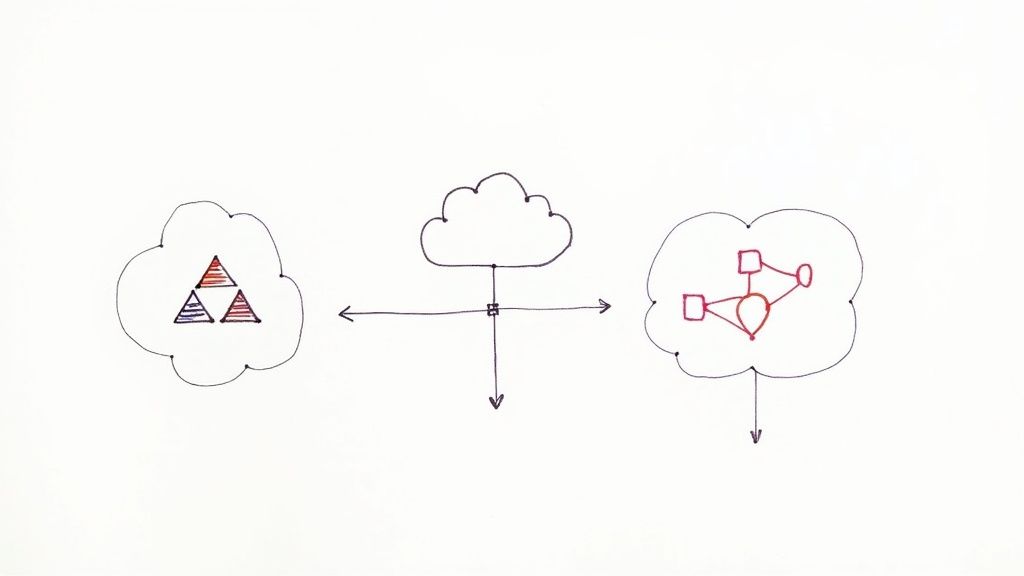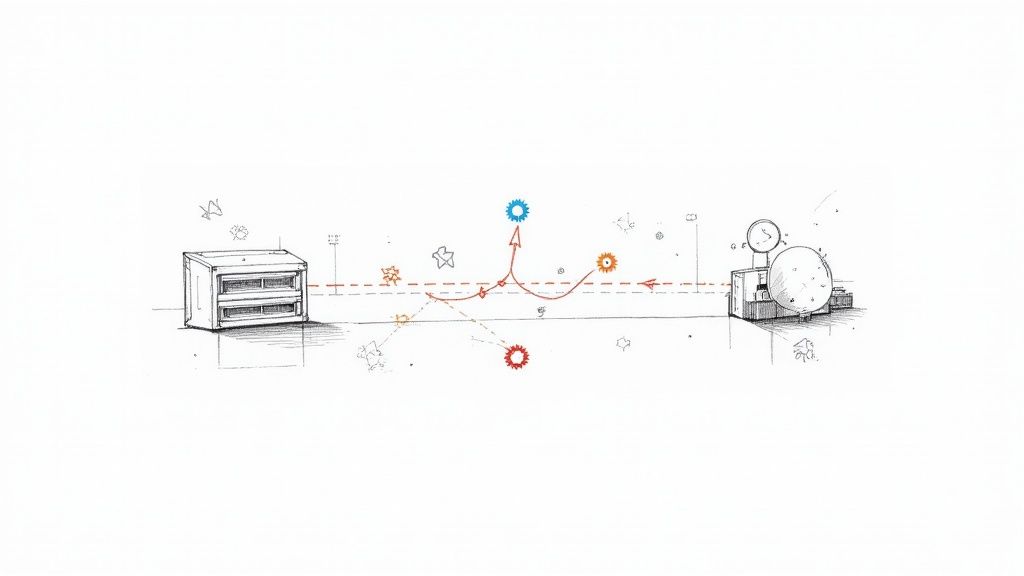change data capture tools: 12 Real-Time Pipelines for 2025

Discover top change data capture tools and how they power real-time pipelines. Compare features, use cases, and pricing for 2025.
In today's data-driven landscape, the latency of yesterday's batch ETL processes is no longer acceptable. Businesses need instant access to operational data for real-time analytics, event-driven applications, and seamless data synchronization. This is where Change Data Capture (CDC) comes in. It's a modern data integration pattern that identifies and captures changes in source databases (inserts, updates, deletes) as they happen, streaming them to downstream systems with minimal impact.
Unlike slow, resource-intensive batch jobs that query entire tables, CDC taps directly into database transaction logs. This method delivers a low-latency, highly efficient stream of changes, forming the backbone of modern data architectures. For data engineers and IT managers, adopting the right change data capture tools is crucial for unlocking the value of operational data without overloading source systems. The challenge, however, is navigating a crowded market filled with platforms offering different capabilities, pricing models, and levels of complexity.
This guide cuts through the noise to provide an in-depth analysis of the 12 best change data capture tools available today. We've done the heavy lifting to help you find the optimal solution for your specific needs, whether you're building a real-time analytics dashboard, synchronizing microservices, or migrating a legacy database. Each entry provides a practical overview, key feature analysis, honest pros and cons, and direct links with screenshots to help you make an informed decision. We'll explore everything from managed SaaS platforms like Fivetran and Streamkap to powerful open-source engines like Debezium, ensuring you can select the right tool to build robust, real-time data pipelines.
1. Streamkap
Streamkap stands out as a powerful, production-ready change data capture (CDC) tool designed to replace slow, batch-based ETL processes with real-time data movement. It excels at capturing data changes from sources like PostgreSQL, MySQL, and MongoDB and streaming them to destinations such as Snowflake, BigQuery, and Databricks with sub-second latency. This makes it an exceptional choice for organizations aiming to build responsive, event-driven analytics and operational systems without the heavy lifting of managing complex infrastructure.
What sets Streamkap apart is its "zero-ops" approach. The platform automates many of the most challenging aspects of data pipeline management, allowing engineers to deploy robust CDC pipelines in minutes. Its ability to handle schema drift automatically prevents pipeline failures when source table structures change, a common pain point in traditional ETL. The platform’s value is further enhanced by its built-in Python and SQL transformation capabilities, enabling data masking, hashing, aggregations, and JSON unnesting on the fly. This eliminates the need for separate transformation tools and simplifies the data stack significantly. You can find detailed explanations of these concepts in Streamkap's guide to CDC for streaming ETL.
Key Differentiators & Features
Streamkap positions itself as a high-performance, cost-effective alternative to legacy tools. Customer case studies on its site report significant cost reductions (54-66%) and performance gains, with claims of being up to 15x faster than competitors. This is achieved by combining low-impact CDC with an efficient streaming architecture that abstracts away the complexities of managing systems like Apache Kafka or Apache Flink.
Pros:
- Performance and Cost: Significantly lower Total Cost of Ownership (TCO) and higher throughput compared to many traditional ETL/ELT tools.
- Ease of Use: Automated, no-code setup allows teams to launch production pipelines rapidly without managing underlying streaming systems.
- Production-Ready: Features like self-recovery, monitoring, and responsive Slack-based support are built for mission-critical workloads.
- Flexibility: Combines the simplicity of a managed SaaS with the power of stream processing and the option to read/write to your own Kafka.
Cons:
- Opaque Pricing: Detailed pricing is not publicly listed; a trial or sales call is necessary to determine exact costs for your specific use case.
- Managed Abstraction: Teams requiring deep, low-level control over Kafka or Flink internals might find the managed platform too abstract.
Website: https://streamkap.com
2. Qlik Replicate (Qlik Data Streaming/CDC)
Qlik Replicate provides a powerful, enterprise-focused solution for real-time data integration and one of the most robust change data capture tools on the market. It excels in moving large data volumes from a wide array of sources like mainframe systems, relational databases (Oracle, SQL Server), and SAP into modern cloud destinations such as Snowflake, Databricks, and Kafka. Its key differentiator is the agentless, log-based CDC architecture, which captures changes directly from source transaction logs. This approach minimizes performance impact on production databases, a critical concern for any organization with high-throughput OLTP systems.
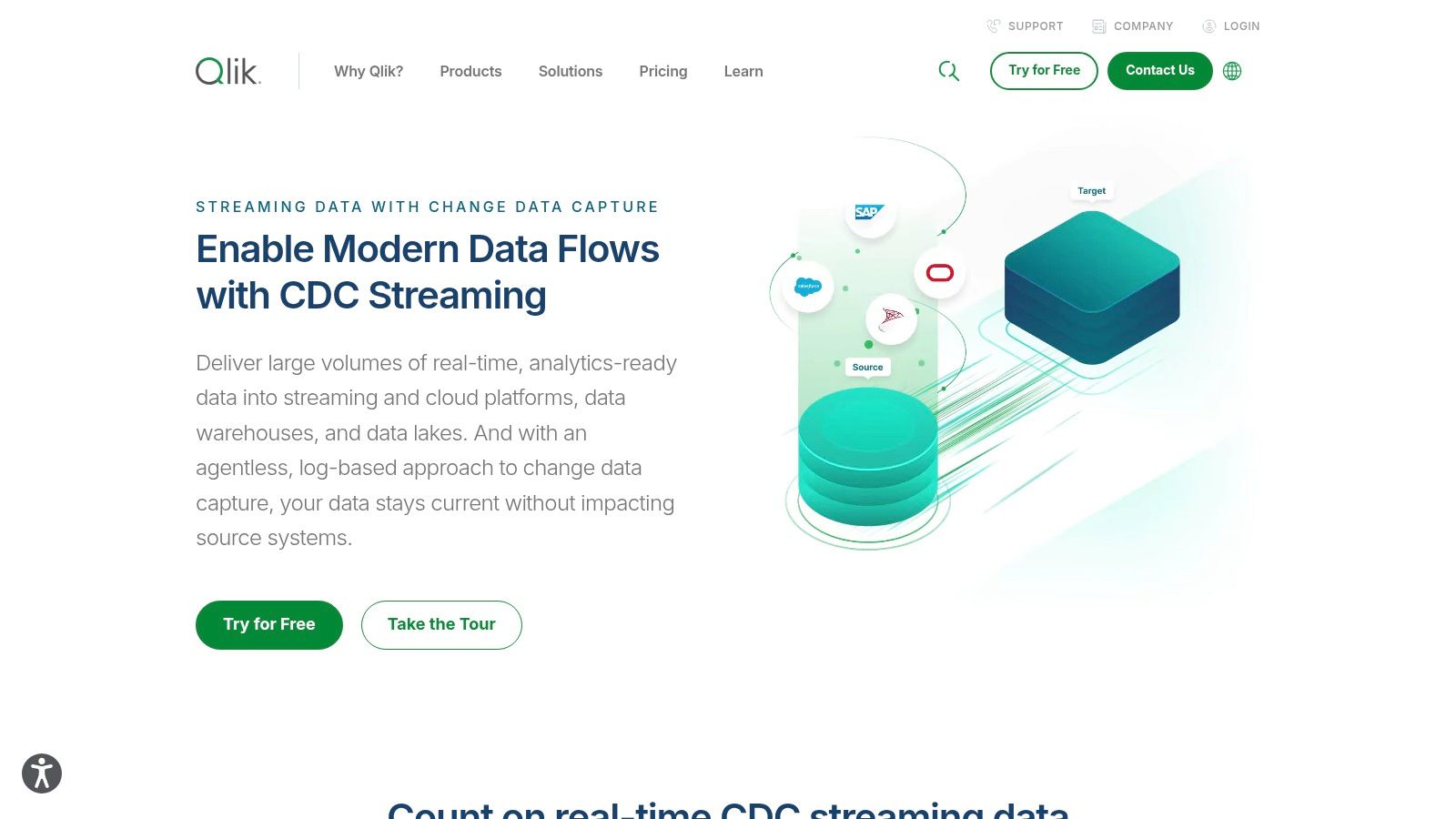
The platform is designed for ease of use, featuring a graphical interface known as the "Click-2-Replicate" experience that simplifies the setup and management of complex data pipelines without extensive coding. This makes it accessible to a broader range of IT professionals, not just senior data engineers.
Key Considerations
Qlik's strength lies in its reliability and suitability for complex, hybrid environments where data must be moved between on-premises legacy systems and multiple cloud platforms.
- Best Use Case: Ideal for large enterprises needing to modernize their data architecture by streaming data from on-premise transactional databases into cloud data warehouses or data lakes for real-time analytics.
- Pricing: Pricing is quote-based and tailored to specific usage, often reflecting its enterprise-grade capabilities. A free trial is available for evaluation.
- Limitations: While powerful, the cost can be a significant factor for smaller organizations. The on-premise version requires self-management of the underlying Windows or Linux server infrastructure.
3. Oracle GoldenGate (including OCI GoldenGate)
Oracle GoldenGate stands as a benchmark for high-volume, mission-critical data replication and is one of the most established change data capture tools available. It specializes in log-based transactional CDC, ensuring data integrity while moving information in real-time between heterogeneous databases. Its deep integration with the Oracle ecosystem is a major draw, but it also provides robust support for non-Oracle sources and targets. The platform's architecture is designed for high availability and low-latency data delivery, making it a staple in industries like finance and telecommunications.
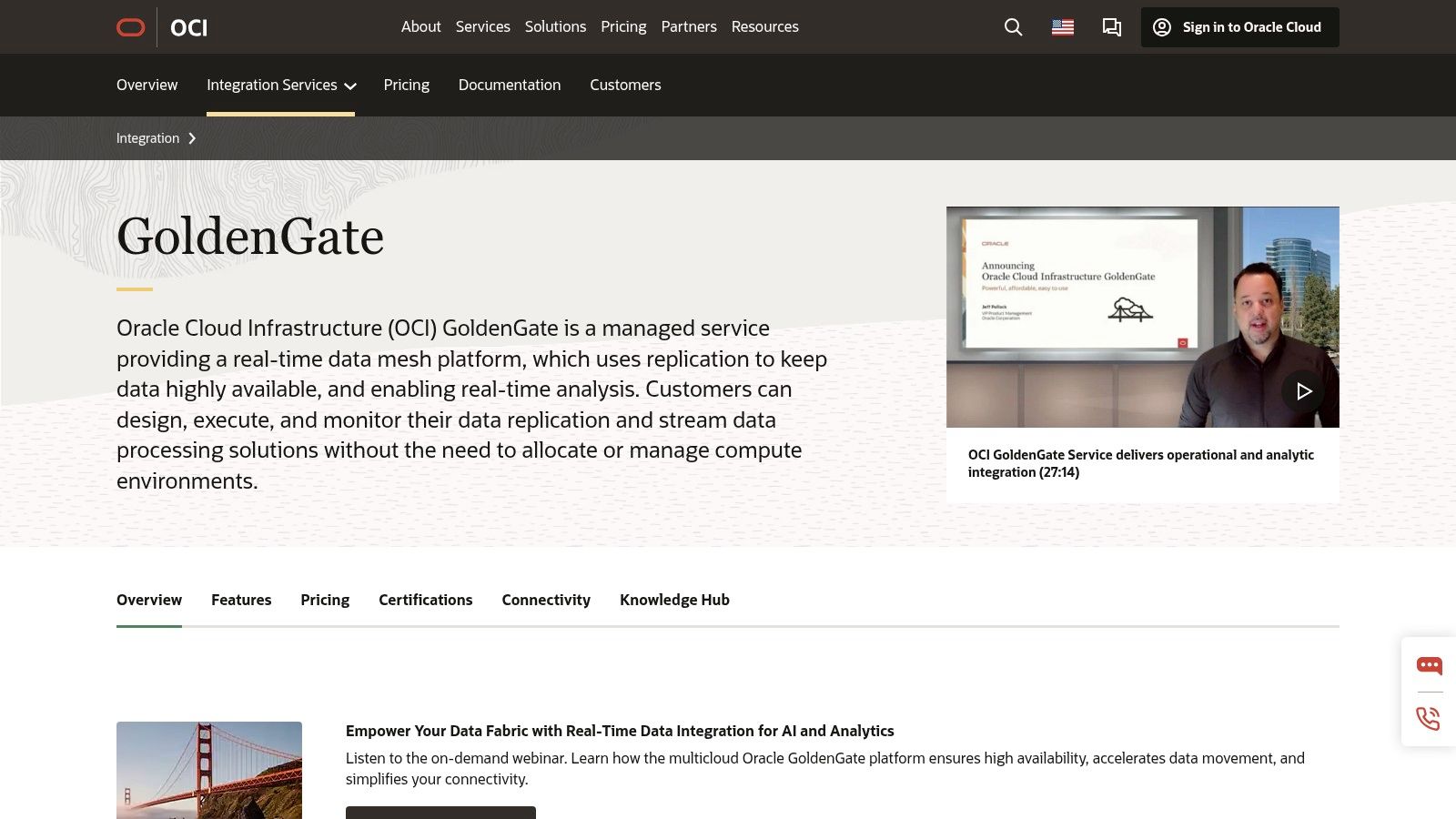
With the introduction of OCI GoldenGate, Oracle offers a fully managed cloud service, significantly lowering the barrier to entry and reducing operational overhead. For those preferring more control, flexible deployment options like container images and a free-to-use version (GoldenGate Free) for smaller databases are also available, catering to a wider range of development and production needs.
Key Considerations
GoldenGate is battle-tested for enterprise-scale workloads where transactional consistency and reliability are non-negotiable. Its flexibility in deployment, from on-premises to a managed cloud service, allows organizations to choose the model that best fits their operational capabilities.
- Best Use Case: Large enterprises requiring real-time data synchronization for disaster recovery, zero-downtime migrations, or feeding transactional data into operational data stores or analytics platforms, especially within a hybrid Oracle and multi-database environment.
- Pricing: Enterprise pricing is quote-based and can be complex. OCI GoldenGate offers a more predictable, consumption-based cloud pricing model. A "GoldenGate Free" version is also available for smaller database environments.
- Limitations: The on-premises version has a steep learning curve and requires significant operational expertise to manage effectively. Licensing costs for large-scale deployments can be substantial.
4. AWS Database Migration Service (AWS DMS)
AWS Database Migration Service (DMS) is a fully managed service designed to help you migrate databases to AWS easily and securely. While its primary purpose is migration, it has become one of the most widely used change data capture tools for continuous data replication, thanks to its robust CDC capabilities. It supports a broad range of sources and targets, with a strong emphasis on moving data into the AWS ecosystem, including destinations like Amazon S3, Redshift, and RDS. Its serverless nature means you don't manage the underlying infrastructure, allowing teams to set up replication tasks quickly.

The service provides ongoing replication using log-based CDC, ensuring minimal impact on source systems. It is deeply integrated with other AWS services like CloudWatch for monitoring, SNS for notifications, and CloudTrail for auditing, offering a comprehensive solution for visibility and operational management within the AWS environment. This native integration is a key differentiator, providing a seamless experience for organizations already committed to AWS.
Key Considerations
AWS DMS shines for its simplicity and powerful integration within the AWS cloud, making it a go-to choice for teams needing to feed real-time data into AWS-native analytics platforms.
- Best Use Case: Ideal for organizations operating within the AWS ecosystem that need a cost-effective, managed solution for real-time data replication from on-premise or other cloud databases into AWS data stores.
- Pricing: Pricing is based on the compute resources (replication instance hours) consumed and data transfer costs. A free tier is available to help users get started with smaller migrations.
- Limitations: While versatile, its performance and ease of use are best when the target is an AWS service. Replicating to non-AWS destinations can be complex and may require workarounds. Advanced tuning is sometimes necessary for high-volume, low-latency workloads.
Visit AWS Database Migration Service (AWS DMS)
5. Google Cloud Datastream
Google Cloud Datastream is a serverless, agentless CDC and replication service tightly integrated into the Google Cloud ecosystem. It excels at streaming data with minimal latency from sources like Oracle, MySQL, PostgreSQL, and SQL Server directly into Google Cloud destinations such as BigQuery, Cloud SQL, and Cloud Storage. As one of the more modern change data capture tools, its primary differentiator is its fully managed, serverless architecture, which eliminates the need for users to provision or manage any replication infrastructure. This allows teams to focus on analytics rather than pipeline maintenance.
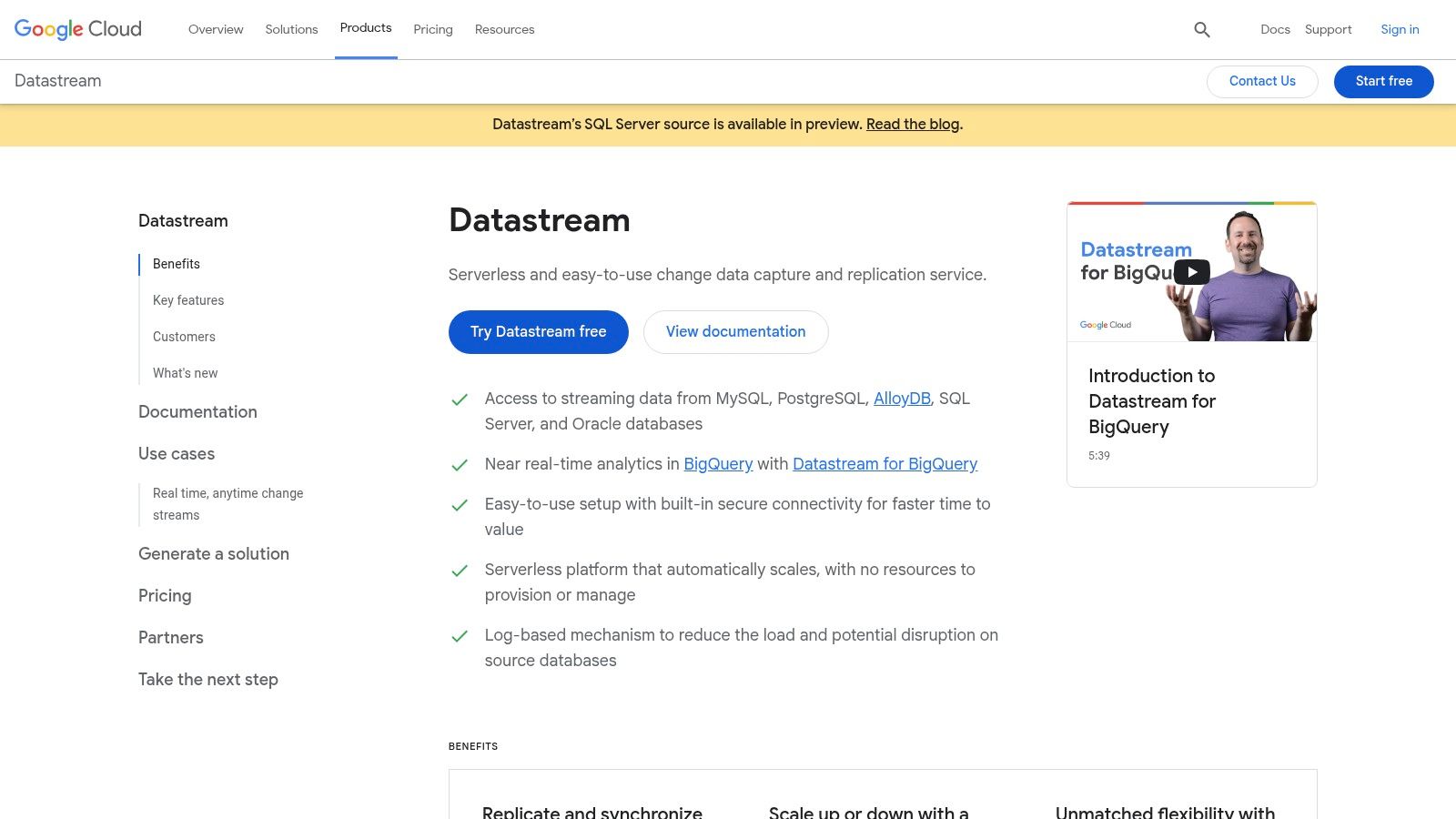
The platform is designed for simplicity and speed within the GCP environment. Its agentless, log-based approach ensures minimal impact on source databases while capturing every change event. This makes it a highly efficient solution for synchronizing operational databases with a cloud data warehouse for real-time reporting and analytics.
Key Considerations
Datastream's strength is its seamless integration and ease of use for organizations already committed to the Google Cloud Platform. It simplifies the creation of real-time analytics stacks by acting as the foundational data ingestion layer.
- Best Use Case: Perfect for companies building real-time data analytics pipelines on GCP, streaming data from operational databases directly into BigQuery for immediate analysis.
- Pricing: Follows a pay-as-you-go model based on the volume of data processed (GB), making it accessible for projects of any scale. A free tier is often available.
- Limitations: The service is heavily optimized for Google Cloud targets. Using it to send data to other clouds like AWS or Azure requires additional services like Cloud Storage and Dataflow, adding complexity and cost. Some source connectors may be in a preview state.
6. Microsoft Azure Data Factory (CDC resource)
For organizations deeply invested in the Microsoft ecosystem, Azure Data Factory (ADF) now offers a native Change Data Capture resource, currently in public preview. This feature provides a fully managed, low-code solution for capturing changes from sources like Azure SQL and SQL Server and delivering them to various Azure destinations. As one of the more recent entrants among change data capture tools, its primary advantage is seamless integration within the Azure environment, eliminating the need for third-party tools or complex pipeline management for many common use cases.

The platform leverages a studio-based graphical interface that guides users through setting up CDC with configurable latency, making it accessible even without deep data engineering expertise. This approach simplifies the creation and monitoring of real-time data ingestion pipelines directly within the familiar ADF workspace, which is a significant plus for existing Azure users. If you're using Azure SQL Database, change data capture is a key technology to enable real-time analytics.
Key Considerations
ADF's CDC functionality is purpose-built for Azure-centric data architectures, providing a straightforward, serverless option for near real-time data movement into services like Azure Synapse Analytics or Microsoft Fabric.
- Best Use Case: Ideal for teams already using Azure Data Factory who need to implement basic, low-latency CDC from supported Azure databases into other Azure services without managing infrastructure.
- Pricing: Follows ADF's consumption-based pricing model. Costs are based on CDC core hours, and you only pay for what you use while the CDC is running.
- Limitations: The CDC resource is still in public preview, meaning its feature set is evolving and may lack the maturity of established tools. The list of supported sources and targets is currently limited, so verify it meets your specific needs.
Visit Microsoft Azure Data Factory (CDC resource)
7. Fivetran
Fivetran has solidified its position as a leader in the automated ELT space by offering one of the most accessible and low-maintenance change data capture tools available. It specializes in providing fully managed connectors that leverage native, log-based CDC for major databases like PostgreSQL, MySQL, and SQL Server. This approach ensures minimal impact on source systems while reliably capturing every change. Its acquisition of HVR (now Fivetran HVR) extended its capabilities to complex, high-volume on-premise and hybrid environments, catering to enterprise-grade requirements.

The platform is designed for data teams who want to focus on analytics, not pipeline management. With over 700 pre-built connectors and native dbt Core integration, users can set up robust data replication pipelines in minutes. Fivetran's core value proposition is its "set it and forget it" nature, automating schema drift handling and recovery from failures without user intervention.
Key Considerations
Fivetran’s strength is its simplicity and speed of deployment, making it a go-to choice for teams prioritizing operational efficiency over deep pipeline customization.
- Best Use Case: Perfect for teams of all sizes looking for a fully managed ELT solution to quickly and reliably centralize data from various SaaS applications and databases into a cloud data warehouse.
- Pricing: Follows a transparent, consumption-based model based on Monthly Active Rows (MARs). A free plan is available for low-volume use cases, and a pricing estimator helps forecast costs.
- Limitations: The MAR pricing model can become expensive for high-volume, high-churn tables, requiring careful monitoring. Customization options for data transformations before loading are limited compared to code-first or self-managed tools.
8. Striim
Striim is a unified, real-time data streaming and integration platform that provides powerful log-based change data capture tools for a variety of enterprise databases. It is engineered to collect, process, and deliver data with sub-second latency, making it a strong choice for operational intelligence and real-time analytical workloads. The platform uses native log readers for sources like Oracle, SQL Server, and PostgreSQL, ensuring minimal impact on production systems while capturing every insert, update, and delete. Its key differentiator is the ability to perform in-flight transformations and enrichments as data streams from source to target.
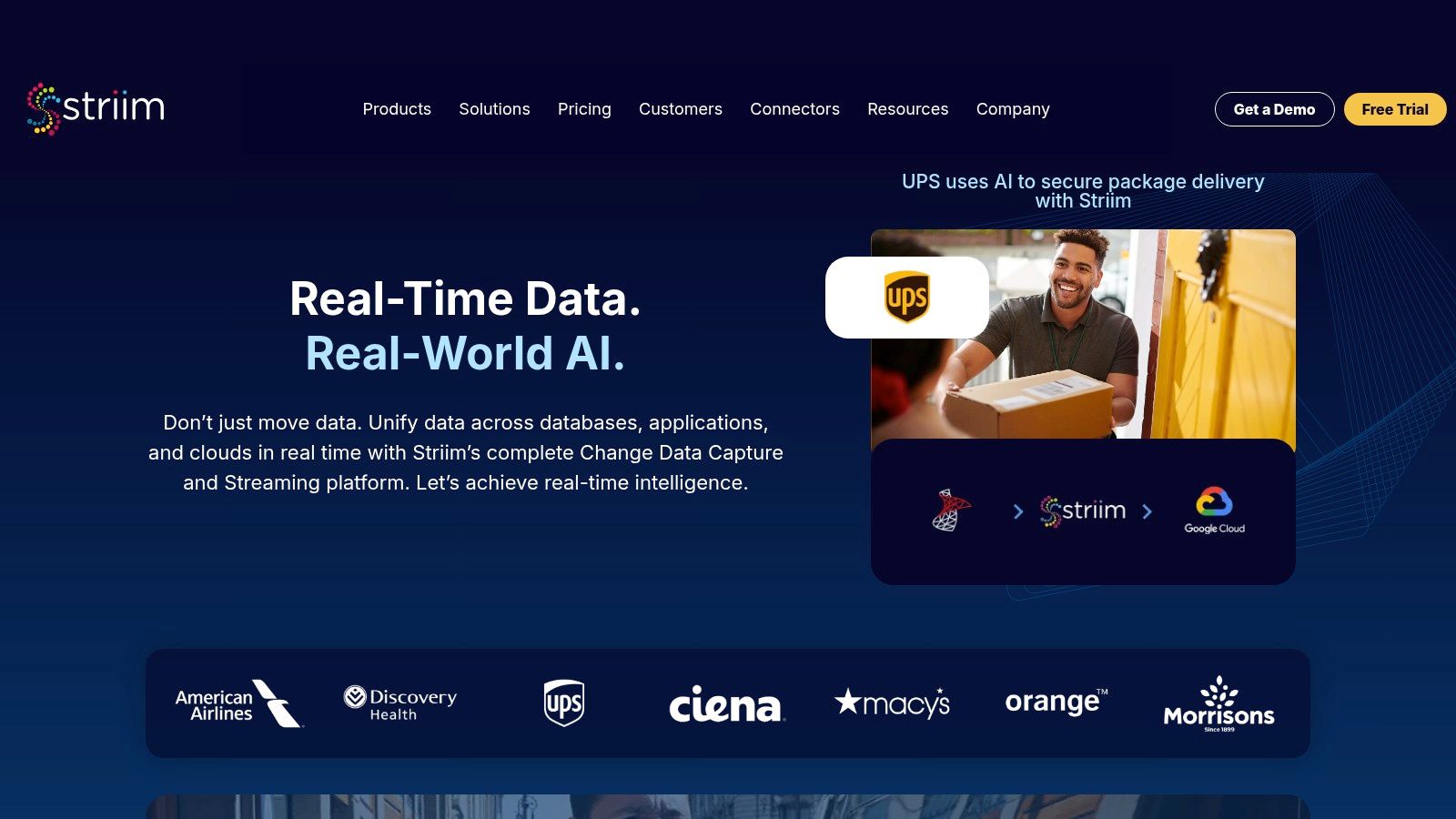
The platform offers a visual, SQL-based development environment that simplifies the creation and deployment of data pipelines. This drag-and-drop interface, combined with helpful wizards for CDC setup, allows users to build sophisticated streaming applications without deep coding expertise. Striim is well-suited for feeding real-time data into cloud data warehouses like Snowflake, BigQuery, and Redshift, as well as messaging systems such as Kafka.
Key Considerations
Striim excels in use cases where low-latency data is critical for immediate business decisions, such as fraud detection, real-time inventory management, or feeding live operational dashboards.
- Best Use Case: Enterprises that need to build real-time analytical applications by streaming and processing transactional data from on-premise databases directly into cloud platforms.
- Pricing: Pricing is quote-based and tailored for enterprise needs. A free trial is available to test the platform's capabilities.
- Limitations: The cost structure is geared toward larger organizations, which might be a barrier for smaller companies. While powerful, the self-managed components of the platform may require operational overhead for performance tuning and maintenance.
9. Confluent Hub (Kafka Connect marketplace)
Confluent Hub is less a standalone tool and more of an essential ecosystem for organizations building real-time data pipelines with Apache Kafka. It functions as a central marketplace for discovering and downloading connectors for Kafka Connect, including a wide array of powerful change data capture tools. The Hub hosts popular CDC source connectors like the Debezium family (for PostgreSQL, SQL Server, MongoDB, and more), as well as connectors from other vendors, providing a one-stop-shop for integrating various databases with Kafka. This simplifies the often complex process of finding, vetting, and installing the right component for a given data source.

The platform offers components for both self-managed Kafka Connect clusters and fully-managed connectors within Confluent Cloud. For self-managed setups, the confluent-hub command-line interface streamlines the installation process. For cloud users, it allows for the deployment of pre-built, supported connectors with minimal configuration, abstracting away the operational overhead of managing the Kafka Connect framework itself.
Key Considerations
Confluent Hub’s value is in centralizing the discovery and deployment of CDC connectors for the Kafka ecosystem, making it a critical resource for any team leveraging Kafka for data streaming.
- Best Use Case: Data engineering teams using Apache Kafka or Confluent Platform who need to source real-time event streams from various transactional databases. It is perfect for building a decoupled, event-driven architecture.
- Pricing: The Hub itself is a free resource. The cost is associated with running the underlying Kafka and Kafka Connect infrastructure, whether self-managed or through a Confluent Cloud subscription.
- Limitations: This approach requires foundational knowledge of Kafka and the Kafka Connect framework to operate effectively. The availability and versioning of fully-managed connectors on Confluent Cloud can lag behind the open-source releases.
10. Debezium
Debezium is a premier open-source distributed platform for change data capture, built on top of Apache Kafka. It captures row-level changes in your databases and streams them as event records to Kafka topics. As one of the most popular open-source change data capture tools, it provides a suite of mature source connectors for databases like MySQL, PostgreSQL, SQL Server, and MongoDB, enabling real-time data synchronization, microservices data exchange, and cache invalidation. Its core strength is its tight integration with the Kafka ecosystem, making it the de-facto standard for log-based CDC in Kafka-centric architectures.
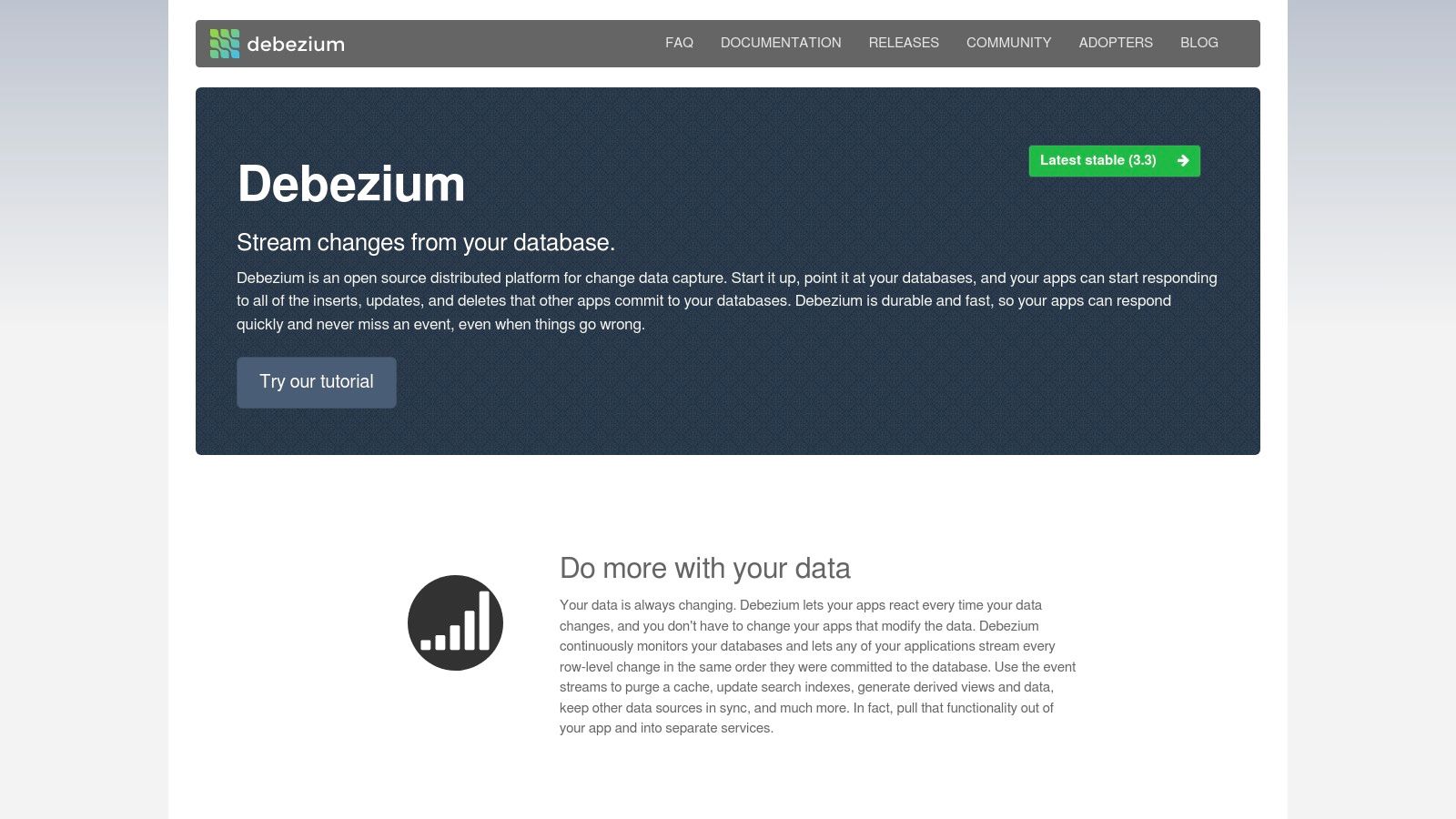
The platform is designed to be durable and fault-tolerant by leveraging Kafka Connect's distributed and scalable framework. This design ensures that change events are delivered reliably, even in the event of component failures. The active community contributes to a frequent release cadence, continuously adding features and improving existing connectors. You can learn more about its application in our guide to PostgreSQL Change Data Capture.
Key Considerations
Debezium's power comes from its flexibility and deep integration with Kafka, but this also means you are responsible for managing the entire infrastructure stack.
- Best Use Case: Ideal for engineering teams building event-driven microservices or real-time data pipelines who are already invested in or planning to adopt Apache Kafka.
- Pricing: Completely free and open-source (Apache 2.0 license). Costs are associated with the self-managed infrastructure (e.g., Kafka, Kafka Connect, servers, storage).
- Limitations: Requires significant operational overhead to deploy, manage, and scale the underlying Kafka and Kafka Connect infrastructure. Configuring certain connectors, like Oracle, can be complex, and there is no dedicated enterprise support outside of commercial distributions like Red Hat's.
11. Airbyte
Airbyte has rapidly emerged as a leading open-source data integration platform, offering robust ELT capabilities with a strong focus on extensibility. While primarily known for its vast library of connectors, it also provides powerful change data capture tools for sources like PostgreSQL, MySQL, SQL Server, and MongoDB. Its architecture allows users to choose between a self-hosted open-source version for maximum control or a managed Airbyte Cloud for ease of use. The platform's key differentiator is its open-source nature, fostering a vibrant community that contributes to a rapidly expanding ecosystem of over 600 connectors.
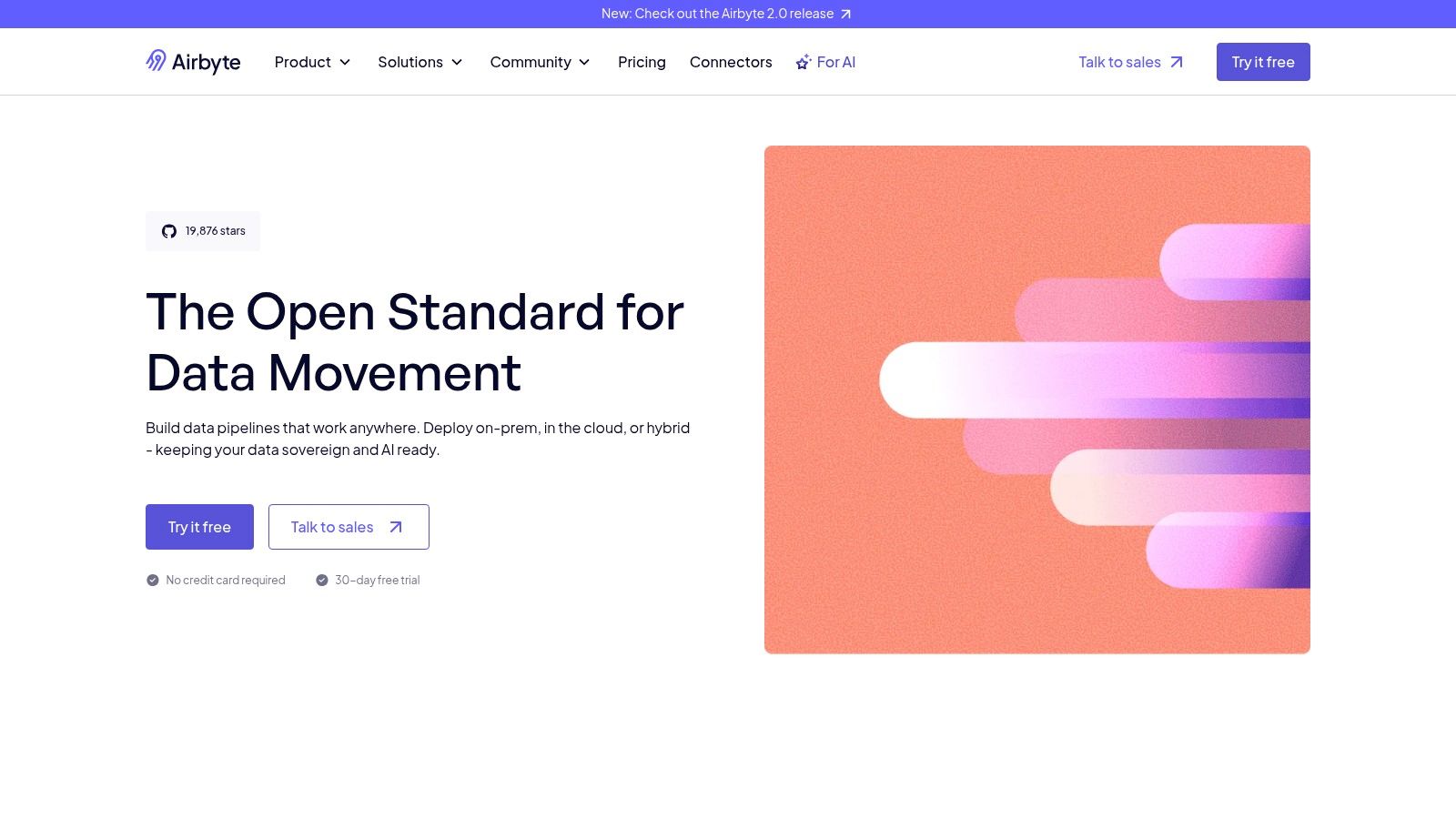
Airbyte’s CDC implementation is primarily log-based and designed for incremental replication, capturing changes from database transaction logs. This approach is well-suited for batch-oriented ELT workflows where data freshness is important but not necessarily at the sub-second level required for true real-time streaming. The platform's Connector Development Kit (CDK) further empowers engineering teams to build custom connectors for bespoke or niche data sources.
Key Considerations
Airbyte’s flexibility makes it a compelling choice for teams that value customization and community-driven development over a purely proprietary, black-box solution. It democratizes data integration by making CDC accessible without enterprise-level costs.
- Best Use Case: Ideal for startups and scale-ups needing a cost-effective, flexible ELT solution with CDC to sync transactional databases with a data warehouse like BigQuery or Snowflake for analytics.
- Pricing: The open-source version is free to use. Airbyte Cloud offers a free tier for low-volume usage and a credit-based pricing model that scales with consumption.
- Limitations: The CDC functionality is more batch-oriented than a continuous stream, which may not suit ultra-low-latency use cases. Managing a large-scale, self-hosted deployment requires significant DevOps and platform engineering expertise.
12. AWS Marketplace (CDC listings)
AWS Marketplace serves as a centralized catalog for discovering, procuring, and deploying third-party software and services, including a wide array of change data capture tools. Rather than a single tool, it’s a procurement platform where organizations can find and subscribe to CDC solutions from various vendors like Fivetran, Qlik, and Striim. This simplifies the acquisition process by integrating software costs directly into the existing AWS bill, streamlining budgeting and vendor management for teams already invested in the AWS ecosystem. The marketplace allows for deployment via SaaS subscriptions or pre-configured Amazon Machine Images (AMIs), accelerating setup within a user's cloud environment.
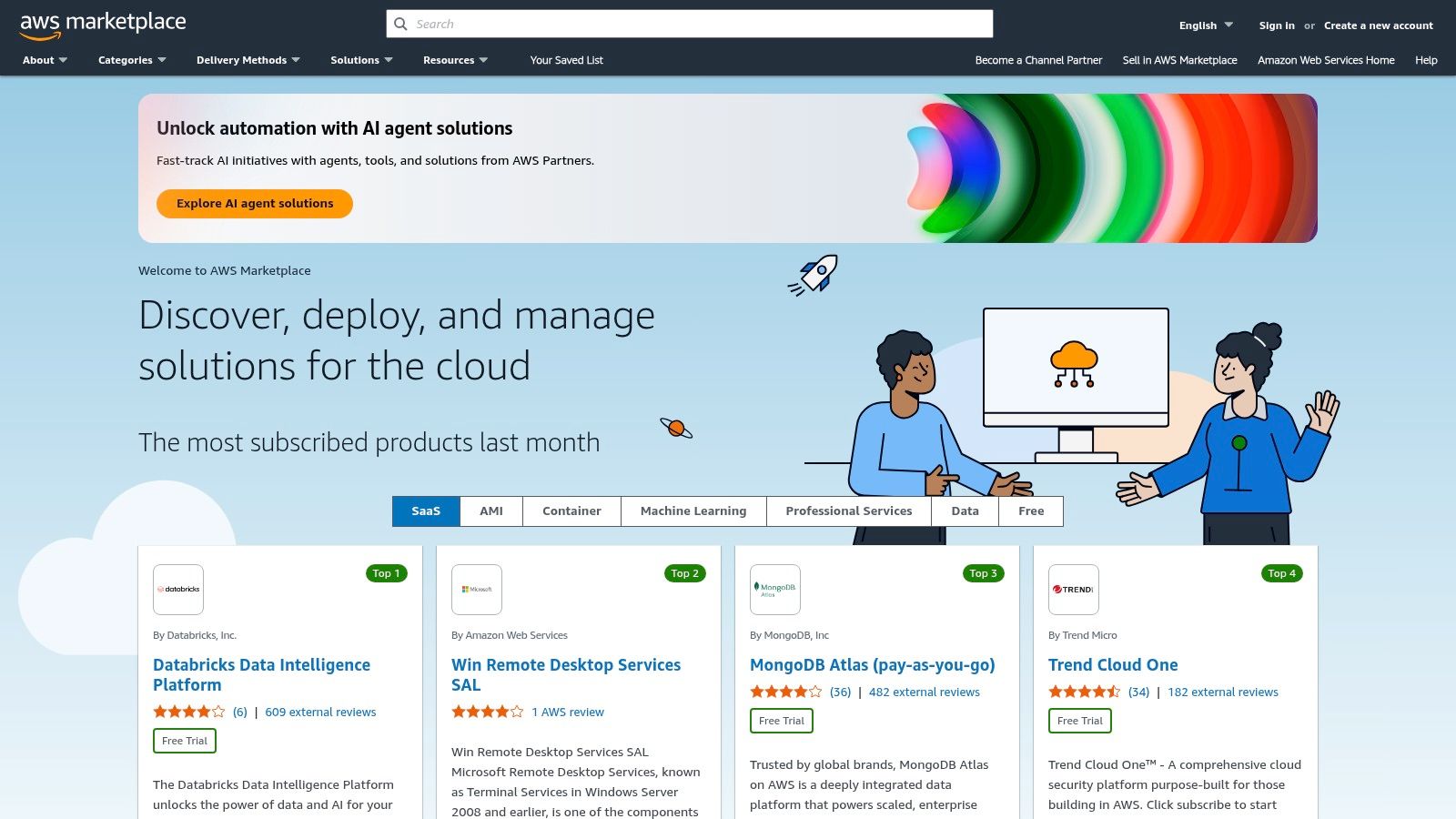
The platform’s key advantage is simplifying the evaluation and purchasing cycle. Users can often access free trials or pay-as-you-go pricing models, enabling them to test different CDC tools with minimal commitment. Each listing provides detailed information on supported sources, targets, and compliance certifications, helping teams quickly narrow down options that fit their specific technical and governance requirements.
Key Considerations
AWS Marketplace is not a CDC tool itself but a powerful enabler, ideal for organizations wanting to consolidate their software procurement and management within the AWS cloud.
- Best Use Case: AWS-centric organizations looking to quickly evaluate, purchase, and deploy a third-party CDC solution with unified billing and simplified vendor management.
- Pricing: Varies significantly by vendor and product. Pricing models include hourly/annual subscriptions for AMIs and SaaS contracts, with costs for the software and underlying AWS infrastructure usage.
- Limitations: The quality and feature sets of the listed tools are inconsistent, requiring thorough vetting by the user. The sheer number of options can also be overwhelming without a clear set of evaluation criteria.
Top 12 CDC Tools — Side-by-Side Comparison
Making the Right Choice: How to Select Your CDC Tool
Navigating the landscape of change data capture tools can feel overwhelming, but as we've explored, the diversity of options reflects the varied needs of modern data teams. From fully managed serverless platforms to powerful open-source engines, the right tool is the one that best aligns with your technical architecture, business objectives, and operational capacity. The decision is no longer just about moving data; it's about activating it in real time to drive immediate value.
The key takeaway from our deep dive is that there is no single "best" CDC solution for everyone. Your choice represents a critical architectural decision with long-term implications for scalability, cost, and agility. What works for a lean startup building a serverless analytics stack will differ significantly from the needs of a global enterprise modernizing its legacy data warehouses.
Key Factors to Guide Your Decision
To make an informed choice, distill your requirements down to a few core evaluation criteria. This process will help you filter the extensive list of change data capture tools down to a manageable shortlist.
Consider these critical factors:
- Source and Destination Connectivity: Does the tool natively support your specific databases (e.g., PostgreSQL, MongoDB, Oracle) and target systems (e.g., Snowflake, BigQuery, Kafka, Redpanda)? Limited connectivity can lead to brittle, custom-coded workarounds that increase technical debt.
- Latency and Performance: What are your real-time requirements? For use cases like fraud detection or dynamic pricing, sub-second latency is non-negotiable. Evaluate how each tool handles high-volume transactions and its architectural approach to minimizing replication lag.
- Management Overhead: Do you have a dedicated platform engineering team to manage and scale infrastructure like Kafka and Kafka Connect clusters? Or would a fully managed, serverless solution that eliminates operational burdens provide a better return on investment and faster time to market?
- Data Transformation and Schema Handling: Real-world data is rarely perfect. Assess the tool's ability to handle schema evolution automatically, perform in-flight transformations, and cleanse data before it reaches the destination. Tools like Streamkap excel here by integrating with popular transformation tools.
- Total Cost of Ownership (TCO): Look beyond the initial license or subscription fee. Factor in infrastructure costs, engineering and maintenance hours, and the potential cost of downtime or data loss. A cheaper open-source tool like Debezium might have a higher TCO once you account for the engineering effort required to run it in production.
Your Actionable Next Steps
With these factors in mind, the path forward becomes clearer. If your organization is heavily invested in a specific cloud provider, native tools like AWS DMS or Google Cloud Datastream offer a logical starting point for their seamless integration. For enterprises with complex, hybrid environments and stringent support requirements, established solutions such as Qlik Replicate or Oracle GoldenGate provide battle-tested reliability.
For teams seeking maximum control and customization, and who possess the requisite engineering skills, the open-source ecosystem centered around Debezium offers unparalleled flexibility. However, for the growing majority of data teams who need to deliver real-time pipelines without the operational drag of managing complex infrastructure, modern managed platforms present the most compelling value proposition. They abstract away the complexity, allowing your engineers to focus on building data products, not managing data plumbing.
Ultimately, the goal is to empower your organization with fresh, reliable, and accessible data. The right change data capture tool is a catalyst, unlocking the potential for real-time analytics, event-driven microservices, and a more responsive, data-informed business culture. The investment you make in selecting and implementing the right CDC solution will pay dividends across every data-driven initiative you launch.
Ready to build real-time data pipelines in minutes, not months? Streamkap provides a serverless, fully managed platform for streaming change data capture, built for performance and scale without the operational headache of managing Kafka or Debezium. Try Streamkap for free and experience the future of real-time data integration today.

